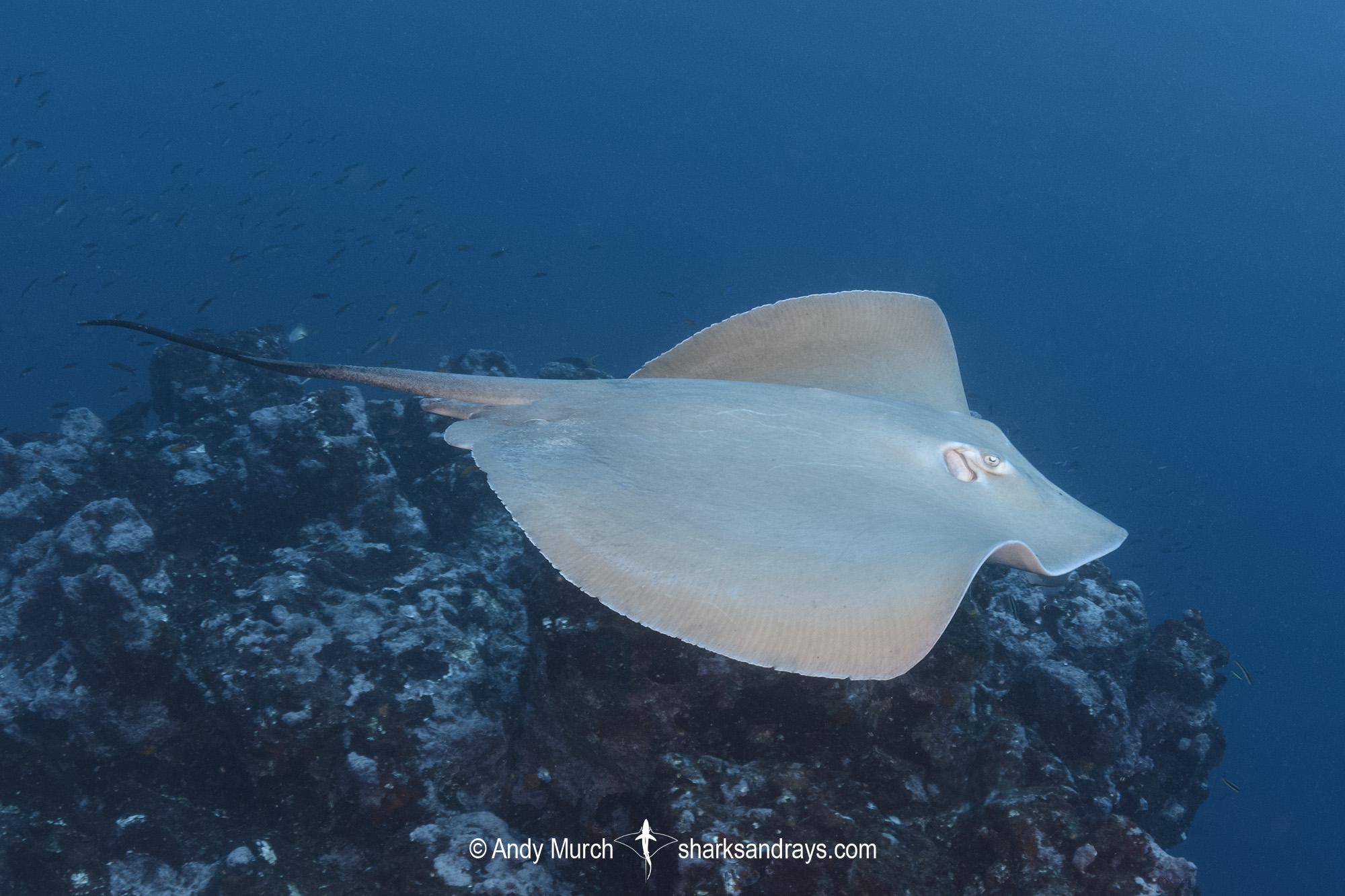Common names
Pink Whipray, Tahitian Stingray.
Binomial
Pateobatis fai.
Synonyms
Himantura fai
Identification
A large stingray with a kite-shaped disc that is wider than long; disc width approximately 1.1-1.2 x length. Snout fairly short, and obtusely angular. Apical lobe (snout tip) triangular, slightly extended. Anterior margins of disc straight or weakly concave. Pectoral fin apices angular. Pelvic fins large; apices narrowly rounded.
Eyes small and slightly protruding. Snout length 1.9-2.3 x combined eye and spiracle length.
Mouth small, containing 4 oral papillae; 2 central papillae very large, lateral papillae very small. Prominent labial furrows and folds around mouth. Lower jaw slightly arched. Nasal curtain slightly skirt-shaped; posterior margin finely fringed.
A small, vague band of denticles on mid-shoulder in young animals, absent in adults exceeding 90cm DW. Tail long and narrow; sub-circular in cross-section, tapering gently to caudal sting, then filamentous to tip. Sparse small denticles on tail beyond caudal sting. Tail length (when intact) 2-2.6 x disc width. Caudal finfolds absent. One caudal sting usually present.
Colour
Dorsum grey-brown or pinkish. Pale spots anterior to eye and between eye and spiracle. Ventrum white with a broad dark margin that starts posterior to mouth level. Tail beyond caudal sting fades to black.
Size
Maximum disc width 186cm. Disc width at birth approximately 30-55cm.

Conservation Status
VULNERABLE
The Pink Whipray (Pateobatis fai) is a retained bycatch species in gillnet, trawl, and dropline fisheries throughout Southeast Asia and parts of the Indian Ocean. In Southeast Asia and in parts of the Indian Ocean fishing pressure is intense. It is especially prevalent in rhynchobatid fishery in the Arafura Sea. Pink Whipray populations in Australia are considered stable. Since the introduction of turtle exclusion devices (TEDs) bycatch of large stingrays has been significantly reduced. Within MPAs in parts of the Great Barrier Reef Marine Park, pink whiprays are considered common.

Habitat
Tropical seas. On sandy substrates and reef rubble, often adjacent to reefs. From shallow bays to inner continental shelf. Intertidal to 200m.
Distribution
Indian Ocean and west/central Pacific. Recorded from South Africa and Egypt but absent (or presently unrecorded) in East Africa. Population more consistent from India, through Southeast Asia (including southern Japan) to northern Australia. Also eastward to Samoa and French Polynesia.
Reproduction
Histotrophic viviparity. Litter size unknown.
Diet
Predates mainly on small fishes and prawns.
Behavior
Known to form large mating(?) aggregations of up to 25 animals during the summer months.
In Nuku Hiva, French Polynesia, on multiple occasions I have observed small groups and individual pink whiprays swimming horizontally in midwater, next to a reef face.
Reaction to divers
Shy unless accustomed to divers. Then, fairly nonchalant unless approached too closely.
Diving logistics
Pink whiprays are very common in southern Queensland, best spots to see them being Manta Bommie and Flat Rock off Brisbane, Wolf Rock off Rainbow Beach and around Heron Island. They are also seen at many spots in the Maldives.
Nuku Hiva (the main island in the Marquesa Archipelago in French Polynesia) is also a good area for these rays. No particular dive site stands out but any spot with an accessible sandy bottom should be good. At a site called the Sentinel, near Taioha’e I encountered three pink whiprays swimming together in mid-water.
What’s new
View our full list of updates
Similar species
Jenkins’ Whipray A similar ray from the Indo-West Pacific. Distinguishable by a prominent row of thorns along midline in adults.





